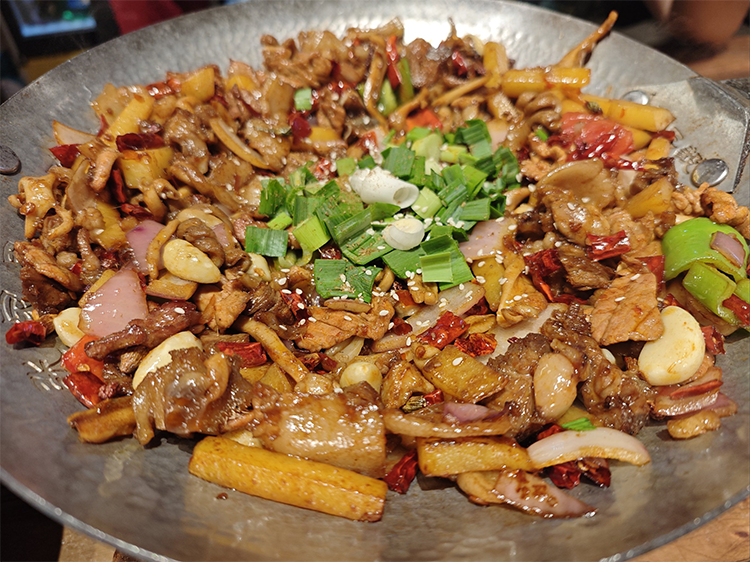Zhangjiajie Sanxia Guo: Xiangxi’s Spicy Stew
Imagine a steaming, spicy bowl filled with the aroma of smoked pork, chilies, and rich broth—that’s Sanxia Guo, a dish born from the culinary wisdom of Xiangxi’s Tujia people. This hearty stew blends rustic mountain ingredients and fiery flavors, offering the warm, comforting taste of home for generations of locals. In Zhangjiajie’s winding alleys, when kitchen smoke rises and a bold aroma fills the air, you’ll know a pot of Sanxia Guo is simmering nearby.
1. Seeking Xiangxi Flavor: A Bowl Carrying Centuries of History
Sanxia Guo is more than just food—it’s history in a bowl. The dish traces back to the Ming dynasty and was once known as a “soldiers’ meal,” prepared by the Tujia and Miao families. When cured meats, tofu, and chilies meet in a single pot, the result is a bold, rustic symphony that captures the essence of Xiangxi’s mountain life. Its popularity has endured for centuries, spreading from home kitchens to restaurant tables across Zhangjiajie.
2. Born from War: The Origin of Sanxia Guo
Legend has it that during the Jiajing reign of the Ming dynasty, Xiangxi soldiers were called to the coast to fight invaders. Their wives, in a rush to prepare nourishing food, tossed whatever they had—smoked pork, tofu, radish—into one pot. This simple, practical stew kept the soldiers full and strong. Over time, that battlefield necessity evolved into today’s Sanxia Guo, a beloved home-cooked comfort dish that symbolizes Xiangxi resilience and ingenuity.

3. “Three” Is No Longer Fixed: Ingredients and Flavor Possibilities
The name Sanxia Guo literally means “Three-in-a-Pot,” but modern variations go far beyond three ingredients.
You’ll find countless combinations across Zhangjiajie:
- Classic trio: smoked cured pork, tofu, and radish—the original and most nostalgic version.
- Offal feast: pork intestines, pig stomach, and beef tripe—rich and surprisingly mild when cleaned well.
- Meat lovers’ version: pork, lamb, or beef for a fuller, deeper flavor.
- Vegetarian take: mushrooms, bean curd, and local greens deliver satisfying umami with less heat.
Each version maintains the dish’s signature qualities—spicy, fragrant, and hearty.
4. Dry Pot vs Soup Pot: The Ultimate Flavor Decision
Sanxia Guo comes in two equally delicious styles:
- Dry Pot: Little to no broth, ingredients seared in oil and spices. The flavors are concentrated, intensely fragrant, and perfect with plain rice.
- Soup Pot: Generous broth similar to hotpot, offering a lighter yet rich flavor. Enjoy the ingredients first, then cook noodles or rice in the leftover soup for a second round.
Both styles feature Xiangxi’s signature flavor trio—ma (numbing), la (spicy), and xiang (fragrant)—creating a deep, multi-layered taste that lingers.

5. How to Eat It Like a Local
To enjoy Sanxia Guo like the locals, follow these tips:
- Best companion: Always pair it with hot white rice to soak up the rich sauce.
- Cool down the spice: A cold local beer or sour plum juice helps balance the heat.
- Taste order: Try each ingredient plain before dipping it into chili or sesame-garlic sauce.
- Local secret: After finishing the main ingredients, locals often toss noodles or vermicelli into the remaining broth—turning leftovers into another satisfying dish.
6. Traveler Tips: Where and When to Try Sanxia Guo
- Where to eat: Skip fancy spots—authentic flavor lives in small family-run eateries or market stalls in Yongding and Wulingyuan districts.
- Spice level: If you’re not used to Xiangxi’s fiery heat, ask for mild or less spicy.
- Best season: Enjoy it year-round, but autumn and winter are ideal when the warmth of the pot contrasts with the cool mountain air.
- Budget: Expect to spend around 50–80 RMB per person, making it one of the best-value local meals in Zhangjiajie.

7. Simple Home Version: Recreate Xiangxi Flavor at Home
You can easily prepare a homestyle version to bring the mountains to your kitchen:
Ingredients: smoked cured pork (or pork belly), firm tofu (or fried tofu), white radish as a base, plus any meats or vegetables you prefer.
Quick steps:
- Blanch smoked pork to reduce saltiness and slice into pieces.
- Heat oil, add Sichuan peppercorns, dried chilies, ginger, and garlic until fragrant.
- Stir-fry the smoked pork until it releases fat, then add tofu and radish.
- Add water—more for soup, less for dry pot—and simmer until tender.
- Season with soy sauce, cooking wine, and a pinch of sugar.
- Garnish with scallions or cilantro before serving.
The home version might not match Zhangjiajie’s restaurant intensity, but it captures the same warmth and spirit of Xiangxi cooking.

8. Conclusion: A Taste of Xiangxi’s Heart
A bowl of Sanxia Guo tells the story of Xiangxi—its history, courage, and love of bold flavors. Born from necessity and perfected by generations, this simple yet powerful dish continues to comfort locals and surprise travelers. When you visit Zhangjiajie’s misty mountains, don’t leave without trying Sanxia Guo. In every spicy, smoky bite, you’ll taste the soul of Xiangxi—humble, hearty, and unforgettable.


